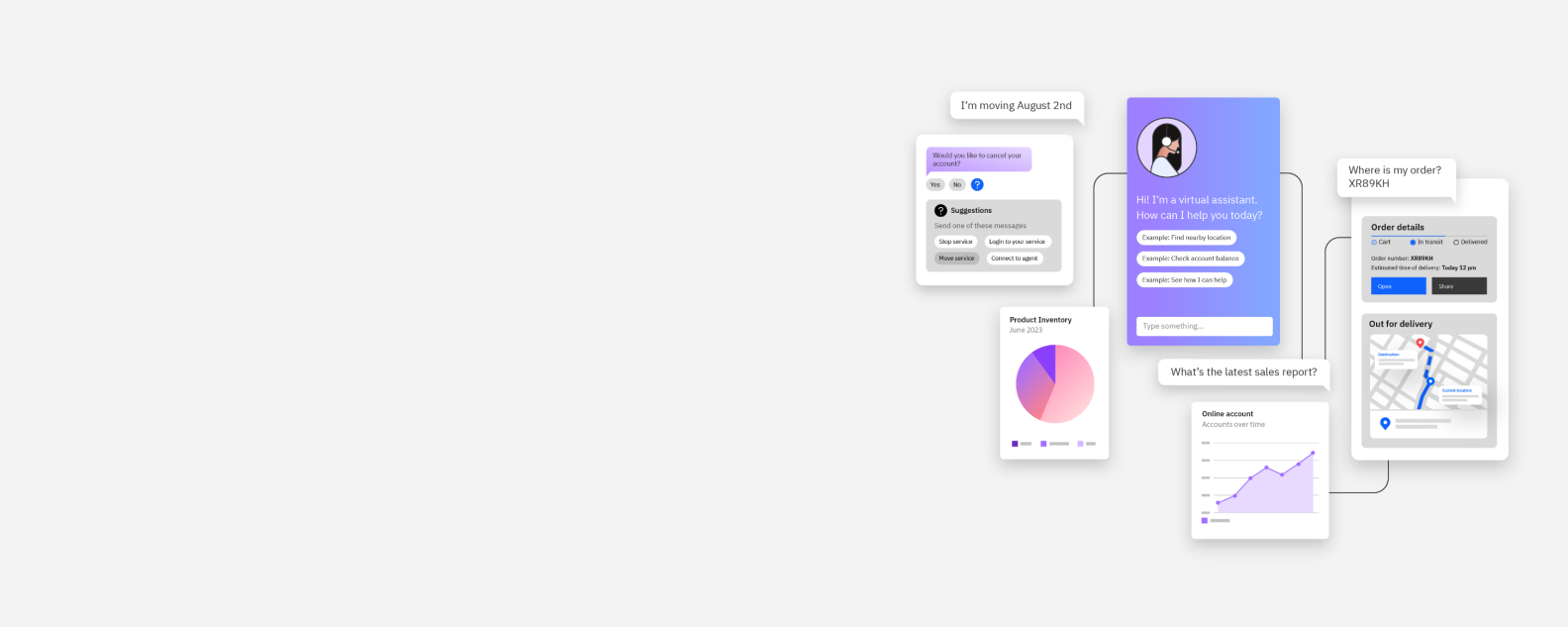Explore IBM watsonx Assistant pricing plans to create an omni-channel customer experience.
- Everything you need to get started
- World-class conversational AI with watsonx Assistant
- Create engaging user interactions using images, buttons and more
- Scale and secure your assistant with enterprise-grade support and data governance
- Set up a 1:1 meeting with our sales team to price out your use case
Webchat
Telephony/Voice Add-on
SMS and MMS
Messaging channel integrations
Custom Channel API
Monthly active users
Up to 1,000
1,000+
50,000+
Assistants
3
10
30
Analytics data retention
7 days
30 days
Up to 90 days
Published versions per assistant
1 version
10 versions
50 versions
Session timeout limit
5 minutes
24 hours
7 days
Industry leading NLP (Natural Language Processing)
Customer service desk integrations
Search existing content
Ask clarifying questions
Change conversation topic
Analytics with problem identification
Autolearning
Export chat logs
Segment integration
Concurrent call capacity
100
1,000 (higher limits available)
Phone integrations
SMS/MMS
Support for SIP call transfers
Connectivity to existing IVRs
Multiple lanauge support
Neural voice synthesis
Language, acoustic and voice cusomizations
Private endpoints
Activity tracker
Onboarding support
Data isolation
With Data Isolation Add-on
Leverage log data across instances
With Data Isolation Add-on
Number of instances
Billed per instance
Billed per instance
Up to 30 with Data Isolation Add-on
Batch intent classification
With Data Isolation Add-on
HIPAA enabled
With Data Isolation Add-on
Uptime SLA
99.5%
99.9%
Deploy on any cloud, including IBM, Amazon, Google, Microsoft, or on-premises environments
Contact us
Get started using watsonx Assistant
A monthly active user (MAU) is any unique user who has at least one meaningful interaction with your assistant or custom application over the calendar billing month. A meaningful interaction is an exchange in which a user sends a request to your service and your service responds. Welcome messages that are displayed at the start of a conversation are not charged.
A unique user is recognized by the user ID that is associated with the person that interacts with your assistant. The web chat and other built-in integrations set this property for you automatically.
You can calculate MAUs on your own, for both IBM Cloud and IBM Cloud Pak for Data.
To learn more, please visit us here.
If you’re using our REST API or web chat integrations, you need to provide us with a unique identifier (created by you) for each user that interacts with your assistant. We recommend a non-human identifiable database ID (such as a GUID) that doesn’t change throughout your customer lifecycle. If you’re using our Facebook, Slack or Intercom integrations, we pull the user ID from these sources automatically.
If you’re using our REST API and you don’t have a userID because your user is anonymous, we recommend that you generate your own randomized IDs using something like UUID (link resides outside of ibm.com).
If you’re using web chat and a user doesn’t have an identifier provided by you, we will generate one for your user and cookie them with the anonymous identifier in the event that they return to your site later in the month. That way you’ll only be charged once for that user.
If messages are sent with two different userIDs then yes, you will be charged twice. We recommend either prompting users to log in prior to initiating a chat or using the anonymous value for that user throughout all of their sessions.
We will charge based on the session identifier automatically, meaning that if this user returns a second time within the month after their session expires, they will be treated as two MAUs.
watsonx Assistant currently supports 13 languages and 1 in beta. However, support coverage differs from feature to feature. For a detailed view of the product’s support coverage by feature, go here.
The Plus plan starts at USD 140 and includes up to 1,000 monthly active users (MAUs). Additional MAUs are billed at USD 14 per 100 MAUs. When a user connects on voice, there is an additional cost of USD 9 per 100 voice MAUs.
To learn more about the Plus Plan and user-based metering, please visit us here.
The Enterprise with Data Isolation plan provides a number of additional security and privacy capabilities, including deployment in a single-tenant environment, support for HIPAA compliance, an increased number of instances and a longer retention period of analytics data.
Footnotes
* Prices shown are indicative, may vary by country, exclude any applicable taxes and duties, and are subject to product offering availability in a locale.
